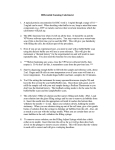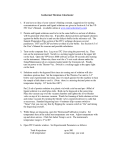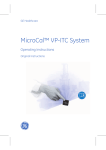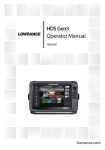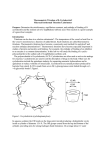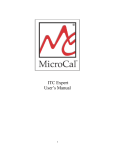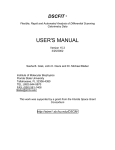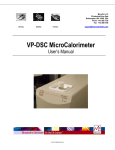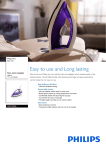Download 2 mg/ml ca
Transcript
Differential Scanning Calorimeter 1. A typical protein concentration for DSC work is 1 mg/ml though a range of 0.1— 2 mg/ml can be used. To look for aggregation or other events, you can start at 2 mg/ml and then decrease concentration. When deciding what buffer to use, keep in mind that some components (e.g., DTT or metals) can have their own heat transitions which the calorimeter will pick up. 2. The protein solution should be dialyzed overnight against the buffer it's in. Filter the solution to remove any particulate matter. Both sample and buffer need to be degassed, starting with the solutions at room temperature if possible. Degas for at least 5 minutes with stirring if possible. 3. The DSC functions best when it's left on all the time. It should be on and the VPViewer software open when you arrive. You may want to run a water/water scan if this is the first time you've used the DSC. This will give you familiarity with filling the cells, the trickiest part of the procedure. In the User's Manual there are tutorials for running water/water scans, for refilling the cells during a run, and for running a lysozyme scan. 4. Even if you are an experienced user, you need to start with a buffer/buffer scan using the buffer you will use for your actual experiments. This will give the instrument a "thermal history" for the experimental run and will result in more repeatable data. You also need this baseline for your data analysis. If the baseline is flat near zero DP units, it means the cells are well equilibrated. 5. Set the instrument for many upscans and downscans (maybe 20) and have the first several be your buffer/buffer runs. (To make all the upscans the odd-numbered ones, choose Unique Scans, Odd, then enter the starting and final temps. Follow a similar procedure for making the downscans the even ones.) Once those look good, refill the sample cell with your real sample during a PreScan Thermostat so you don't lose the thermal history. The feedback setting needs to be the same for the buffer/buffer scans and the sample/buffer scans. 6. Set the temperature at which you would like to start your first run by going to the Thermostat/Plot Control window and setting it there. The machine will thermostat at that temperature until a scan is initiated. The temperature range available is -10° to 130°. (See the Additional Notes for details.) 7. The cells hold ~500ul of solution and the narrow filling neck holds ~85ul. (For filling the cells we recommend NOT using the filling funnel since it almost guarantees that you'll have bubbles in your sample.) Load your solution into the glass filling syringe and be sure to remove air bubbles from it. Insert the needle into the appropriate cell until it touches the bottom then withdraw the needle 1—2 mm. Inject your solution slowly, leaving the needle stationary. When you see solution rising up out of the cell stem, give a few quick bursts of solution from the syringe to dislodge air bubbles from the cell. Also, stir as much as you can with the syringe needle. When you are certain there are no more bubbles in the cell, withdraw the filling syringe. To remove excess solution, use the filling adjust syringe which has a thick collar on its needle. Insert that into the cell as far as it will go then draw back slowly on the plunger to remove excess solution. This will insure that the volume in each cell is correct and will give cleaner baselines. 8. Secure the white cap onto the cell port by turning the lower portion of the cap as far as it will go. Then turn the top portion of the cap to increase pressure to ~30 psi, watching the pressure window at the top of the main window. 9. When you are considering your run parameters, look at section 4.3 (page 40) of the User's Manual for some useful hints about scan rates and starting/ending temperatures. Data is stored on the C: drive in the "user_data" folder. Make a personal folder there. For data analysis, put your data directly on the C: drive so the Origin software can find it. 10. On the DSC Controls window, set the total number of scans (upscans and downscans) you want, from 1 to 200. Set the Post Cycle Thermostat to the temperature you want after the last scan has finished. Enter Cell Concentration for later data analysis. This is the concentration (mM) of the solution in the sample cell. 11. Now set the Scan Edit Mode. See an explanation of the options in section 3.3 (page 25) of the User's Manual. Then set the parameters for your scans: Starting Temperature (T1), Final Temperature (T2), Scan Rate (deg./hr.), PreScan Thermostat (15 min. recommended), PostScan Thermostat (min.), Filtering Period (sec.), FB Mode/Gain and Data File Name (ends in .dsc). Recommended scan rate maxima are 90 deg./hr. for upscans and 60 deg./hr. for downscans. For slow (protein) transitions, a filter period of 10—20 sec. is appropriate. The appropriate FB (feedback) mode choice for proteins is None. 12. Data File Comments can be entered in the box so named but will only apply to selected scans. To apply them to all scans, check Apply Comments to all. The Cell Refill Parameters help you do your refilling at the same part of each cooling downscan. Checking Use Audible Fill Indicator will activate a beep once the machine has reached the top of the refill temperature range you have specified. It is recommended that you specify a 10 degree window below any regions of sample transition. 13. To start your run, click on the Start flag. If you need to change any parameters during the run, go to the DSC Controls window, make the changes, then click on the Update Run Parameters icon on the top toolbar to enter the changes. 14. If you need to stop the run prematurely, click on the Stop icon. Otherwise, the machine will perform all the scans and return to the PostScan Thermostat temperature. 15. To do your data analysis, see the Analyzing DSC Data protocol (on the website) which is a quick reference guide to the Origin Tutorial Guide manual. 16. Remove your sample from the sample cell. If there was no precipitation and you're setting up more scans, rinsing the cells 3X with your buffer should suffice. If you are finished with the machine, remove your sample and buffer and rinse the cells 3X with a detergent solution. (5% Liqui-Nox is recommended.) Then rinse the cells thoroughly with water and leave them filled with water. 17. If your sample precipitated, you will need to clean the cells more extensively. See section 4.5 (page 42) of the User's Manual for various options and/or consult with Debby. If your sample contains lipid, see the special cleaning protocol in Additional Notes. 18. Leave the VPViewer software open and the calorimeter turned on. Updated: 5/29/07 Note: This protocol is a practical hands-on guide to using the instrument. Reading this is not a substitute for reading the manufacturer's manual, something we strongly recommend that you do.



